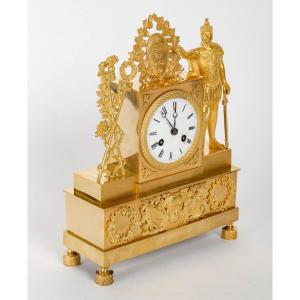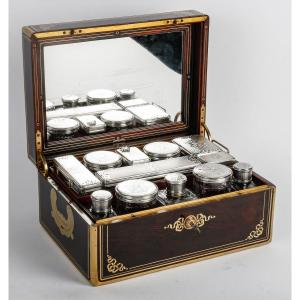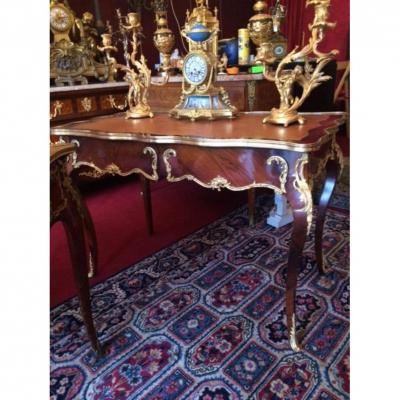---------------
Charm and poetry define this delightful little timepiece, which declines, in a neo-rococo style, a most dreamlike allegorical subject: The Chariot of Love.
Set on an oval base in "Peach Blossom" marble, it immediately seduces our gaze with an exquisite sculptural composition made of delicately chiseled double-patina bronze. With a design as original as it is harmonious, the latter depicts, gracefully nestled in a gleaming Chariot in the shape of a marine Conch, a cute Cherub with plump shapes modeled with suavity. Captured in a lively and dreamy attitude, this smiling and zealous Messenger of Venus, goddess of Love, pretends to follow the progress of the divine vehicle carried by a pair of Doves fluttering, wings spread, above clouds with stylized undulations.
Hemmed, adorned on its profiles, its bulges with enveloping and opulent Rocaille motifs (half-shells with wavy edges, fan-shaped palmette shell, clasps, turn-ups, crosslets and volutes of acanthus or leafy palms) decorated with floral garlands and scattered with rosebuds - just like the Doves, Venusian attributes -, the body of the Chariot serves as a setting in its lower part simulating a wheel* for the movement and circular white enamelled dial of the clock. Indicating the hours, minutes in Roman and Arabic numerals by two pierced and gilded bronze hands, the latter bears the signature of "Susse Frères/ Paris" -, distinguished Publishers and Founders of Art Bronzes of the Parisian capital of the 19th century whose reputation still runs. Stamped with the same protagonists on the reverse of the molded listel setting the sculptural composition, this charmingly inventive timepiece adapts to the pendulum object one of the constituent elements of the bronze effigy presented by Auguste Moreau (Dijon, 1834-Malherbes, 1917) at the Salon des Artistes Français in 1893 (no. 3210): Le Lever de l'Aurore, also called Le Char de L'Aurore, shortly preceded (Salon des Artistes Français in 1890) by Le Char de L'Amour, which received enthusiastic approval from the Parisian public of the time. Treated in a style that is at once elegant, light and graceful, these two poetic female figures with an allegorical subject interpreted with verve the more academic Aurora descending from her Chariot (1686-1697-Paris, Musée du Louvre, MR 3243) sculpted by Laurent Magnier on a model by François Girardon (1628-1715).
Delightfully coquettish, the model of this small timepiece delivered by the artist for the approval of Maison Susse Frères is fully in line with the corpus of "these works, suave little childish groups, graceful and smiling or simple figures of a tender and delicate effect" that Auguste Moreau, inventive, loved to model throughout his prolific artistic career. Delivered to the edition (Susse Frères, E. Godeau-Lapointe, E. Colin, ..), these "will provide" as Henry Haved noted at the turn of the century "to our interiors a decorative note all the more appreciated, as they are treated with science and conscience".
As such, this small Char de L'Amour will enamel with its neo-rococo graces any feminine support (lady's desk, living room table, chest of drawers, bedside table, ..).
* reference to the typology of clock pieces called "Chariot Pendulum" which, appeared at the beginning of the 19th century, have never ceased to meet with great success among lovers of antique clocks for their ingenuity both technical and formal.
---------------------
Related bibliography: Kjellberg, Pierre, Les Bronzes du XIXe siècle: Dictionnaire des Sculpteurs, Paris: Ed. de L'Amateur, 2025, pp. 507-507;- Harved, Henry, The 1906 Salon, in: Revue de l'Art ancien et moderne, T.25, n° 142,pp. 451-452;- Salon des Artistes Français, Explanation of works, paintings, sculptures, ..., 1861-1913
-------------
Marks and Signatures: Dial signed "Susse Frères/Paris". Movement on its plate numbered "19" followed by the initials "C.D". Stamped on the reverse of the group, on the edge of the terrace: "Susse Frères"
Materials: Marble called "Fleur de Pêcher"; Bronze with double brown and gilded patina; painted enamel and glass.
Dimensions: H.: 19 cm;-L.: 18 cm;-Pr.: 10 cm.
Quality Parisian work in Neo-Louis XV Rococo style from the last of the 19th century from the Parisian Maison d'Edition de Bronzes d'Art Susse Frères on a model by the sculptor Auguste Moreau. Circa 1890-1900
Good condition. Beautiful quality of patina, gilding and chiseling. Original movement.


























 Le Magazine de PROANTIC
Le Magazine de PROANTIC TRÉSORS Magazine
TRÉSORS Magazine Rivista Artiquariato
Rivista Artiquariato
